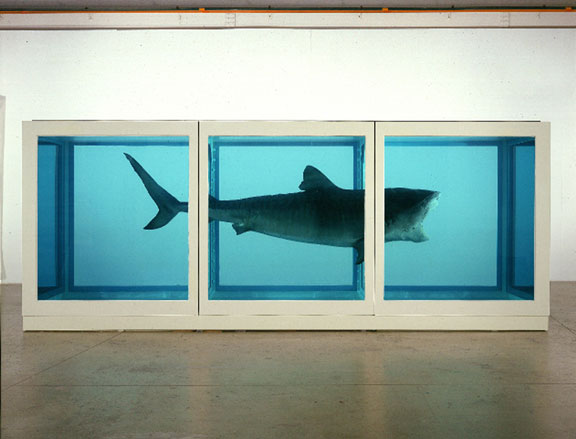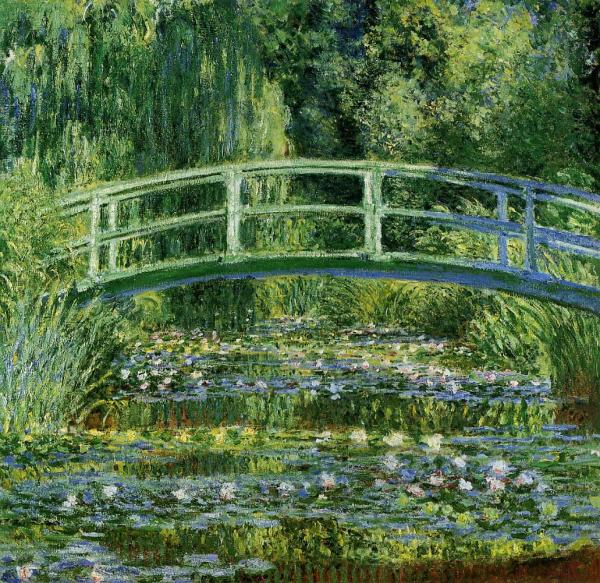Introduction
In the modern-day world of prevailing dynamism, that is moving from progress to greater progress, or better said, beauty to higher beauty in an endless motion, underneath all ostensible pandemonium and bewilderment. The trend, which dominates the globe, is its demonstration of orderliness and maintenance, which display their external mark and at the same time symbolize the inflexible geometry of the cities of the world. In its smoke trails, in its analogous car tracks, and its streets, its factories, and the bridges and its gas tanks, by making use of the underscoring mechanical configuration, the artist could generate a new appearance of optimism through the simple shapes in art forms. The artwork of Damien Hirst is deeply influenced by the modern world of complexities of culture that includes various parameters like social, political, technological, economic, and religious aspects, whereas Claude Monet’s artworks reveal the sense of richness, beauty, and calmness which was the socio-political essence of the late 19th century-early 20th century Europe.
Damien Hirst’s Shark (The Physical Impossibility of Death in the Mind of Someone Living)
Born in 1965, Damien Steven Hirst is considered one of the greatest living English artists and an active member of the YBA or “Young British Artists.” He came into prominence during the early part of the 1990s among the British artists and dominated the art scenario of the UK. Soon he was recognized as a prominent international artist at the beginning of the 2000s. He is almost overwhelmed by the concept of death. It can be stated that his artistic philosophy has been shaped and influenced by two different and opposing essences. One is beauty, and the other is death. It is an interesting factor that these two elements are closely associated with the cultural aspects of the modern world, and the artist has been highly influenced by these elements. (Oriah, 76)

These two elements gave rise to the elements of death and complexities of Hirst’s artwork. The 1991 artwork Shark (originally named The Physical Impossibility of Death in the Mind of Someone Living) by the artist represents a wide view of the influence of modern culture. The main aspect of this picture, from a viewer’s perspective, is to look for the philosophic approach that the painter has taken to enumerate the stability and inconsistency of life. This work of art is exquisite because it places the viewer’s perspective that can be termed as bilateral. It is down-to-earth and materialistic in one way, and at the same time, it renders the spiritual aspects of existence. Not many art forms are capable of evoking such aura, and thus it could be termed as work right out of the grade one hall of fame. Overall, to summarize, it can be specified that the shark presents the most powerful analysis of death and the complexity related to existence and the eternality prevailing with all the differences and barriers imposed. Thus, more widely, the term ‘death’ can be used to depict a specific type of creative fabrication as engendering by human beings, and the term more often than not implies some extent of aesthetic value, which depicts the sensory or sensory-emotional values of the artist, and sometimes even portrays sentiments and tastes of that person. (Sayre, 110)
Description
The 1991 artwork Shark (or The Physical Impossibility of Death in the Mind of Someone Living) is an 84 x 204 x 84 inches object with a dead tiger shark in formaldehyde solution. It is placed inside a tank of steel and glass and is a property of the Steven and Alexandra Cohen Collection. (Sayre, 114) The tiger shark is 13 feet in length, and its skin is wrinkled with jaws wide open. The shark is placed in the tank in a simplistic manner. It is placed in a straight line devoid of any twists or turns. The entire approach is direct and shocking. The frontal view reveals its dead but fiery eyes, and one can view the settings of triangular teeth in sets. It is like viewing death up, close, and personal.
Cultural and Historical Context
Hirst started his life in a period of history that was a time when the world was going through a difficult phase after the horrors of the war juxtaposed with the influence of the beat generation. It could be mentioned in the initial stages that it was degeneration time. Imperialism had taken its tolls on the world, which was grilling on the last fires of the great wars. The losses were too heavy, and the shocks, almost unbearable. People just lived through a test of the extent-organized cruelty, and purposeful ruthlessness could reach. As far as the future was concerned, the initial tremors of what would lead to a massive cross across the globe were being felt. In this context, it would be relevant to mention that the generation was not finding their existence worthwhile, or in other words, they wanted more out of their life for they hardly knew what to believe. They were not able to keep complete faith in religion, and neither could they abandon it completely. The artistic influence of this time was confusing. They showed that the truth was no longer a romantic affair, but it was more of a compulsion for which even lies would work well if that helps in survival. From these parameters, the formulation of complexities is well defined in Hirst’s work Shark. Simultaneously, the aspects of death also influenced him along with the opening up of the world economy and the concept of the global village. Under this parameter, he understood the influence of an emerging monoculture and homogeneous nature of art philosophy that became more open and adjusting as ever. (Boorstin, 332)
Claude Monet’s Waterlilies (Nympheas or Le Bassin aux Nymphas)
Claude Monet, the distinguished French painter, is also known as Oscar-Claude Monet or Claude Oscar Monet. He was the initiator of French impressionist painting and one of the most unswerving and creative practitioners of the movement’s viewpoint of articulating one’s insight before nature, particularly as relevant to plain-air landscape imagery. The word Impressionism is a consequence of the label of his famous painting Impression, Sunrise. (Tucker, 11)
The imagery formed is so recognizable at the moment that it’s possible to fail to remember that Impressionism brought in a newly multifaceted consciousness for its original spectators. The occurrence of light was superior, and along with that, the physical boldness of the painted exterior was also enhanced. Paint and actuality existed together in finely tuned tension. His illustrious garden at Giverny is presented to be equally a private utopia as well as a very fundamental part of his creative processes. While he time and again refused the utilization of drawing as an essential part of his creative process, which was a stance well documented in talks and discussions with his critics, documents that tend to challenge this view have come out in the recent past. The part that Monet’s graphic work plays as a primary facet of his creative process has intricately been studied and continues to be extensively scrutinized. One of his most famous works is the Waterlilies (Nympheas or Le Bassin aux NymphÃas), one of the series of 250 oil paintings. (Tucker, 143)
Description

Claude Monet’s Waterlilies (or Le Bassin aux Nymphas) was painted (oil on canvas) during 1897-99 on a scale of 39½ × 79⅛ in (100.4 × 201 cm). The subject of the painting is a bridge over a water lilies pond. The painter epitomized Impressionism in this particular canvas more absolutely and added an additional thrust to it to move it further more than any other artist. The style’s extremism was rooted in the resolve to paint not mere reality but the bearing in mind of reality, the act of awareness and perception of nature itself, by presenting how light, particularly bright light, is likely to liquefy the colors and appearance of the scene. The explanation of this effect was anchored in unprompted, broken, prancing brushwork — if possible articulated in paint applied in front of the focused item, en plein air. (Oriah, 219)
Cultural and Historical Context
Monet’s creativity may intuitively appear to be simple, but in actuality, it is a complex phenomenon. His creativity is definitely an elaborate process, with the product being an outcome of the implementation of the creativity. Though author Daniel Joseph Boorstin mentioned in his book ‘The Creators: A History of Heroes of the Imagination’ that “even the greatest Greek sculptures, potters, painters, and architects were not individualists” (Boorstin, 94), it can be stated that art and creativity are fundamentally governed by the flow of emotion influenced by the socio-cultural and political environment of the time. The concept of Europe as a unified cultural sect started along the path of the 1900s, and the basic idea of Europe is that unified perception of thought processes bounded by cultural, social, religious, and political homogeneity. There are other variables to develop this homogeneousness of states in Europe whereby the idea could be put forward along with the relative peace of most of the 19th century. This was backed by a sense of political security with an immense flow of wealth during the time. The 19th century was the era when most of the world was dominated by European empires, and the might of the essence of world leaders influenced every aspect of life, and Monet’s creativity was influenced by this richness, peace, and beautification.
Conclusion
In conclusion, it can be stated that nature is created by itself, while art is the creation of nature. Art knows no death. It is imperishable. The spices of nature are born only to die after a certain space of existence. Art continues indefinitely. Art alone enduring stays to us. Art is never demonstrative; it never catches attention with an exhibitionistic appeal. Obviously, a casual observer scarcely finds anything impressive, a thing of beauty, in it. On the other hand, the eye of a connoisseur never misses it. In the case of both the artworks, this maxim is established to its pinnacle.
Works Cited
Boorstin, John. The Creators: A History of Heroes of the Imagination. New York: Random House, 2004.
Oriah, Michael. What We Ache For: Creativity and the Unfolding of Your Soul. New York: HarperCollins, 2005.
Sayre, Henry. A World Of Art. Upper Saddle River NJ: Prentice Hall, 2006.
Tucker, Phil. Claude Monet: Life and Art. London: Yale University Press, 1987.